by Amineddoleh & Associates LLC | Jan 5, 2024 |
Sotheby’s has had a rocky start to 2024 . The New York Times reports that the auction house is preparing to defend itself in trial next week, in the most high-profile lawsuit the art world has seen since in over a decade.

One of the works Rybololev purchased. Tête by Modigliani. Image via Sotheby’s.com.
Facts of the Case
A Russian oligarch, Dmitry Ryboloblev, is accusing Sotheby’s of aiding in fraud. The trial is based on transactions Sotheby’s oversaw between Rybolobev and a dealer/advisor named Yves Bouvier. Bouvier has been accused of secretly acting as both an art dealer and owner of works he sold to Rybolobev, while Bouvier also represented himself as an art advisor. According to Ryboloblev, playing multiple roles enabled Bouvier to dramatically inflate the estimated value of any art sold, and pocket the difference.
Sotheby’s has been accused of helping Bouvier in his deception. The auction house has been accused of knowing that Bouvier lied to Rybolobev about the price of the artwork that Bouvier paid for it, and then helping Bouvier to adjust the work’s valuation accordingly. It will be difficult to prove that Sotheby’s knew that Bouvier was lying to his client, Rybolovlev. However, the evidence presented at trial could convince a jury that Sotheby’s representatives knew Bouvier was inflating the estimated value of the artwork being sold.
The most damning evidence is (as it always is) found in the digital breadcrumbs: certain emails admitted into evidence indicate that Sotheby’s representatives might have altered their valuations based on Bouvier’s instructions –allowing them to both profit from the difference.
Founder Sought as Expert Voice
The lawsuit may expose some of the secrecy behind the world’s most expensive art dealings, primarily because it involves a jury trial. The entire art world is abuzz with intrigue about the trial, and our founder, Leila, was sought out as an expert voice on this incredibly hot topic.
Leila was quoted in The New York Times, stating “There is so much secrecy in the art world that buyers sometimes don’t know the amount of money being made by others in transactions. . . this case will help to clarify the responsibilities and fiduciary duties owed to clients by dealers and auction houses.”
Anonymity in the Art Market
Our firm previously wrote about the issues stemming from anonymity in the art market here. This new case is expected to further increase transparency around those issues in the art market. It asks difficult questions about where loyalties lie when expectations become blurred and prices shoot sky-high. Another outcome for this trial could be fewer money-laundering schemes hidden in art transactions, because more transparency would give bad actors fewer places to hide.
No matter how this case ends, this trial will be one to watch: it has the potential to initiate a complete overhaul of centuries-old industry practices for art buyers, sellers, auction houses, and dealers around the world.
by Amineddoleh & Associates LLC | Dec 10, 2023 |
In our annual holiday newsletter, Amineddoleh & Associates is pleased to share some of the major developments that took place at our firm and in the art market during 2023. We had a banner year, as we were grateful to work with many returning clients, as well as new ones, including museums, collectors, galleries, artists, and entrepreneurs. We are pleased to share some holiday JOY from us to you.

Grand Central Station. Image courtesy of NannFilms, used with permission.
CLIENTS AND REPRESENTATIVE MATTERS
Hiroshi Sugimoto’s Point of Infinity
Our firm proudly announced the public art unveiling of our esteemed client Hiroshi Sugimoto’s Point of Infinity. The gravity-defying sculpture maintains an optical illusion that the two points of the work will (eventually, even if only in the viewer’s minds’ eye) meet. It is a testament to the genius of Sugimoto as an artistic force. Read more here.
Client Acquires Master Drawings in New York
We proudly represented our client Christopher Bishop and his eponymous Christopher Bishop Fine Art in the acquisition of the art fair Master Drawings in New York. The fair, held annually in January in New York City, focuses on works on paper and features several important galleries, as well as programs with leading institutions. Interested in attending the 2024 event? Mark your calendars for opening day on January 27th. Read more here.
Client Opens New Gallery Space
Our firm was pleased to work with Atamian-Hovsepian Curatorial Practice as it transitioned from freelance curating to unveiling its own inaugural gallery and exhibition space in New York City, focusing on underrepresented artists.
Antiquities Restitutions
Amineddoleh & Associates was involved in a number of cultural heritage restitutions this year, including the return of a valuable marble statue to its country of origin and the return of a collection of historic artifacts to their home overseas.

Snow-covered cabin. Artwork courtesy of Justin Leitner, used with permission.
ART & IP NEWS
One thing we love about the art market is that there is always something unexpected and exciting happening in the art world. Read on for a glimpse at some of our most popular blog posts this past year.
Commercialism v. Transformativeness
In this blog post, our firm examined shifts in copyright law following the decision in Andy Warhol Foundation for the Visual Arts, Inc. v. Goldsmith, et al. This highly-anticipated Supreme Court decision involved application of the fair use test (a test used to determine whether the use of a copyrighted work may be used without permission) to a case with peculiar facts: a photographer (Goldsmith) provided a limited license through Vanity Fair that allowed another artist (Warhol) to use her photograph to create a silkscreen work. Warhol violated the terms of the license, and trouble ensued. Legal scholars hoped that the decision would provide clarification on the test. Unfortunately, the high court’s opinion did not provide much guidance. Curious as to why? Read more here.
Wise Women in Art & Entrepreneurship
Ever wonder where all the great women artists were in your art history lectures? At Amineddoleh & Assoc., we did, too. In honor of International Women’s Day, our firm took a closer look at some of the most talented and undercelebrated women artists in history. We also highlighted our friends at Building 180 – a standout, full-service global art production and consulting agency filling the gap between artists and businesses to create public and private art installations. Read more on our website.
Armenian Cultural Heritage at Risk
Our firm took an exclusive look at the Armenian cultural heritage at risk due to aggression from the Azerbaijani regime. The exodus of Armenians and Azerbaijan’s occupation of Artsakh left Armenian art and architecture unprotected. Artsakh is known as the “Crown Jewel” of Armenian cultural heritage, as it contains some of the most exemplary representations of medieval Armenian architecture, as well as important sites such as the first school to teach the Armenian alphabet in the early fifth century. Also in this post, our firm highlighted the new legal pathway the Republic of Armenia paved when seeking assistance from international courts to help protect their treasures. Read more here.
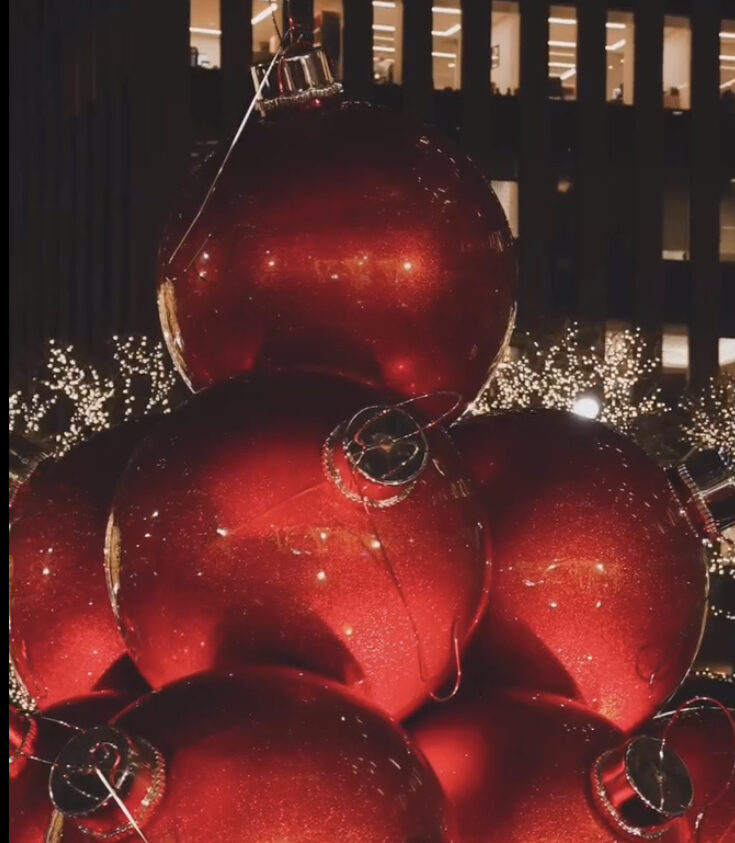
Christmas ornaments on 6th Ave. Image courtesy of NannFilms, used with permission.
LAW FIRM UPDATES AND EVENTS
Firm Founder Listed Again by Chambers
For the second consecutive year, firm founder Leila A. Amineddoleh was recognized by Chambers and Partners High Net Worth Guide for her work in Art and Cultural Property Law. The publication named Leila as an attorney who has “a lot of expertise in the cultural property space,” with “a great courtroom manner.” The publication also remarked on her active presence in the art law space and her work in the litigation area. Read more here. Leila was also named one of the “Top 10 Most Influential Art and Cultural Property Law Lawyers in 2023” by Business Today. For that award, Leila was selected for her “unique touch of fervor to her work, combined with a comprehensive understanding of art law.” Read more about that award here.
Art Law Conferences
Congratulations to our firm’s founder Leila A. Amineddoleh, who successfully chaired the 15th Annual NYCLA Art Law Institute, one of the most anticipated events of the year. Leila also moderated a fascinating panel during the event entitled “Broken Promises: Promised Gifts and Legal Enforceability.” A major theme in the panel was for lawyers to be extremely aware of the time between the time the gift was made, and the time the gift is executed (word to the wise: things can change!).
Yelena Ambartsumian gave a presentation at the conference with Claudia Quinones, one of our former associates (and current friend). The two gave thoughtful insight and wisdom on issues surrounding title and authenticity.

Santa Con NYC in Central Park. Image courtesy of Nycmstar, used with permission.
IN THE PRESS
Leila appeared in the Washington Post and in an article for ABC News this year, in addition to other notable publications. In each, she was consulted as an expert voice on a variety of art and cultural heritage law topics, including discussions on the ethical implications of resolving cultural antiquities ownership disputes.
Additionally, Leila was invited to contribute to the Third Edition of The Art Law Review. Her article, “Cultural Heritage Disputes and Restitution” examines Nazi-looted art disputes, antiquities litigations, government seizures, and ethical concerns related to the acquisition and display of Colonial-era takings. Read more here. Another of Leila’s scholarly publications, “Kings, Treasures, and Looting: The Evolution of Sovereign Immunity and the Foreign Sovereign Immunities Act,” was published in the Columbia Journal of Law & the Arts. Read more here.

Christmas tree at Rockefeller Center. Image courtesy of NannFilms, used with permission.
Leila also was featured in New York Metro Super Lawyers Magazine as a leader in her field. For the article, Leila’s was highlighted as an exemplary, top-rated intellectual property, art, and cultural heritage lawyer well-known in the industry for getting the job done right. Read more here. Leila was also the feature story in Boston College Magazine’s Winter 2023 issue. The story followed Leila’s art law career along with the story of the looted marble bust that was restituted to Germany in 2022. Read more here.
Maria T. Cannon contributed several letters to the Wall Street Journal this past year on AI and the ethical implications of attorneys and artists. She was also published in the ABA’s Art & Cultural Heritage Law Newsletter, Spring 2023 Edition. You can read it here. She also presented two lectures this past year. The first was in Asheville, NC, about the challenges attorneys face when dealing with celebrity-inspired art. Read more here. The second was at Cardinal Gibbons High School on Nazi-looted art. Finally, she completed Artificial Intelligence Governance Professional training through internationally-recognized leader in privacy, information, and cybersecurity law, IAPP.

White birch forest. Artwork courtesy of Justin Leitner, used with permission.
On behalf of Amineddoleh & Associates, we wish you a happy and healthy holiday season and a wonderful and prosperous new year.
P.S. Click here for one last special holiday message from our firm!
by Amineddoleh & Associates LLC | Oct 31, 2023 |
Good news, thrill-seekers! Here at Amineddoleh & Assoc., not only do we provide exquisite legal services for our clients, we also know where to find a good, real-life scare. Our secret? Follow the haunted art!
Read on for our recap of our firm’s top haunted art-themed blog posts. Then, book a ticket to see the haunted art in-person. No tricks here, each destination is a true, Halloween treat.
Witch Way to the Party?
In this recent blog post, our firm traveled to Asheville, NC to get a glimpse at America’s Largest Home – and one of the most haunted. Click the link for all the details on this spooky mansion, including its most famous ghost-in-residence. Not only that, this historic home has a strange room known as the Halloween Room for visitors to experience, plus its own secret connection to protecting American art from Nazi air-raids in WWII. As if that weren’t enough to encourage a click, this post also has dazzling photos of Asheville’s gorgeous fall foliage.

Biltmore House in Autumn. Image via R.L. Terry at Wikimedia Commons.
The Ghoulishly Gory Frescos in Rome’s Santo Stefano Rotondo
Ever see art so gory it incites a physical response? Click here for more info on this real-life syndrome, known as Stendhal Syndrome, in which grotesque art and cultural heritage causes viewers to have palpitations of the heart. For those wanting to experience the syndrome in real-life, look no further than Santo Stefano Rotondo in Rome. While most tourists on a Roman holiday select beautiful frescos at the Vatican, those who venture to Santo Stefano will see a different sort of religious art. Go for the scenes of torture, stay for the bloody depictions of senseless violence. Plan to go before lunch, or else risk spilling the contents of your own stomach at the foot of these cultural works.

Gory frescoes covering the walls of the church. Image courtesy of Leila Amineddoleh, used with permission.
Cursed Art, from Statues to Paintings
Anglophiles, unite! The National Gallery in London is home to one of the most famous paintings in the world. However, this work is not famous for its artistic qualities (though they are divine). Rather, The Rokeby Venus is better-known for its ability to cause viewers to lose their minds. Click here to read all about this painting’s astonishing – and potentially cursed – provenance. The strange stories behind The Rokeby Venus illustrate how all aspects of a work’s life – including whether or not it is cursed – create its provenance. No matter what your opinion is of The Rokeby Venus’ alleged curse, the documented history of strange occurrences attributed to its ownership has become an important part of the work’s provenance.
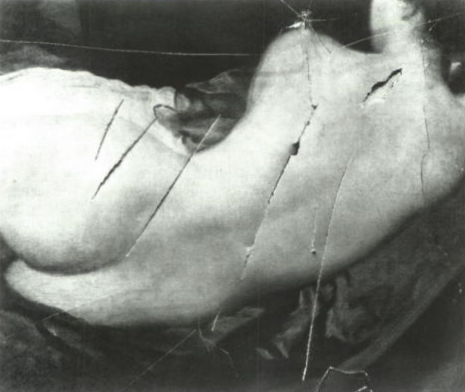
The slashed Rokeby Venus. Image via artinsociety.com.
Haunted Happenings: The Law of Ghosts and Home Sales
If the average Airbnb isn’t scary enough this season, consider visiting a house that’s actually haunted. More and more people are reporting ghosts in domestic settings – and not always friendly ones. Trouble ensues when the place the ghost calls home is up for sale. Lawyers may be faced with the question: is a ghostly presence a condition that must be disclosed prior to sale? Would a reasonable family purchase a house that comes with a frightening ghost? Read more here to discover the actual laws that govern when a family’s new home comes with an unexpected side of ghost.
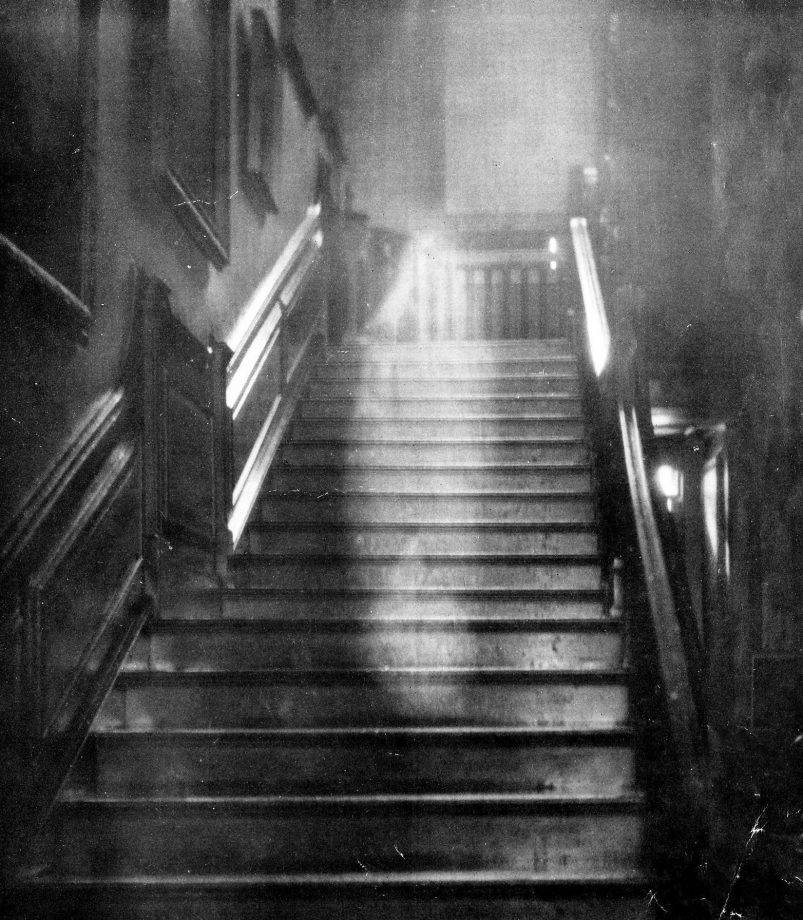
Famous ghost photograph of the Brown Lady of Raynham Hall, originally taken for Country Life (first published in December 1936).
Horrifying Provenance of Monster Manuscripts
This post provides two monstrous holiday destinations in one spooky swoop: ties to Mary Wollstonecraft Shelley’s Frankenstein can be found in both New York City and Oxford, England. Online versions of Shelley’s copious notes and edits for the story can be found on The Shelley-Godwin Archive’s website through the New York Public Library. To pay a visit to the originals, travel to Oxford, where the original transcript are held as part of the Abinger Collection in the Bodleian Library. If that weren’t reason enough to visit Oxford this time of year, stop by Christ Church College for the Harry Potter-esque tour of the storied grounds. Glimpse the inspiration for the wizarding world’s tall towers and cavernous halls on the college campus. Who knows – wizards also might be walking the grounds, masked in their muggle clothes.

Illustration from the frontispiece of the 1831 revised edition of Frankenstein, published by Colburn and Bentley, London 1831.
The Cat’s Meow: Feline Art Lovers
Word on the street is that the husband of our firm’s founder is dressing as a cat for the second consecutive year this Halloween. While we can neither confirm nor deny the Halloween costumes of our firm’s families (or whether or not, in fact, the members of those families were given the freedom to select their own costumes, or if they were selected for them by their young daughters), click here for a post inspired by our culture’s love for cats in art. Thinking of dressing as a cat this year? As our founder’s husband may say, ‘tis the season!
On behalf of Amineddoleh & Associates, we wish you a safe and Happy Halloween this year!
by Amineddoleh & Associates LLC | Oct 17, 2023 |
Wildfires blazed around the world this past summer with alarming intensity. The world is still feeling the effects of gigantic fires and toxic wildfire smoke. Experts continue to work to understand the impacts of these massive fires, particularly for areas that suffered multiple fires. Further complicating matters, many of these sites relied on tourist dollars for their economy. This makes the re-opening of sites (such as West Maui and specified areas on the Hawaiian west coast) fraught for local communities. Residents and government officials alike strive to balance welcoming tourists with a smile and processing their own grief and loss.
Hawaii was not the only place that suffered from wildfires. Greece, Croatia, Italy, Canada and Algeria all faced massive wildfires that obliterated homes, destroyed nature reserves, and threatened precious cultural heritage. In July, fires in Italy destroyed cultural heritage in Sicily’s Santa Maria de Gesù church. A wooden statue of the Blessed Virgin Mary and the remains of St. Benedict the Moor were both completely destroyed. That same month, additional fires on Spain’s Canary Islands forced evacuations of nearly 30,000 people, listed as two of UNESCO’s World Heritage Sites. With so much art, architecture, nature reserves, and other pieces of international heritage in danger, it’s almost as if the wildfires were specifically targeting culturally protected areas.
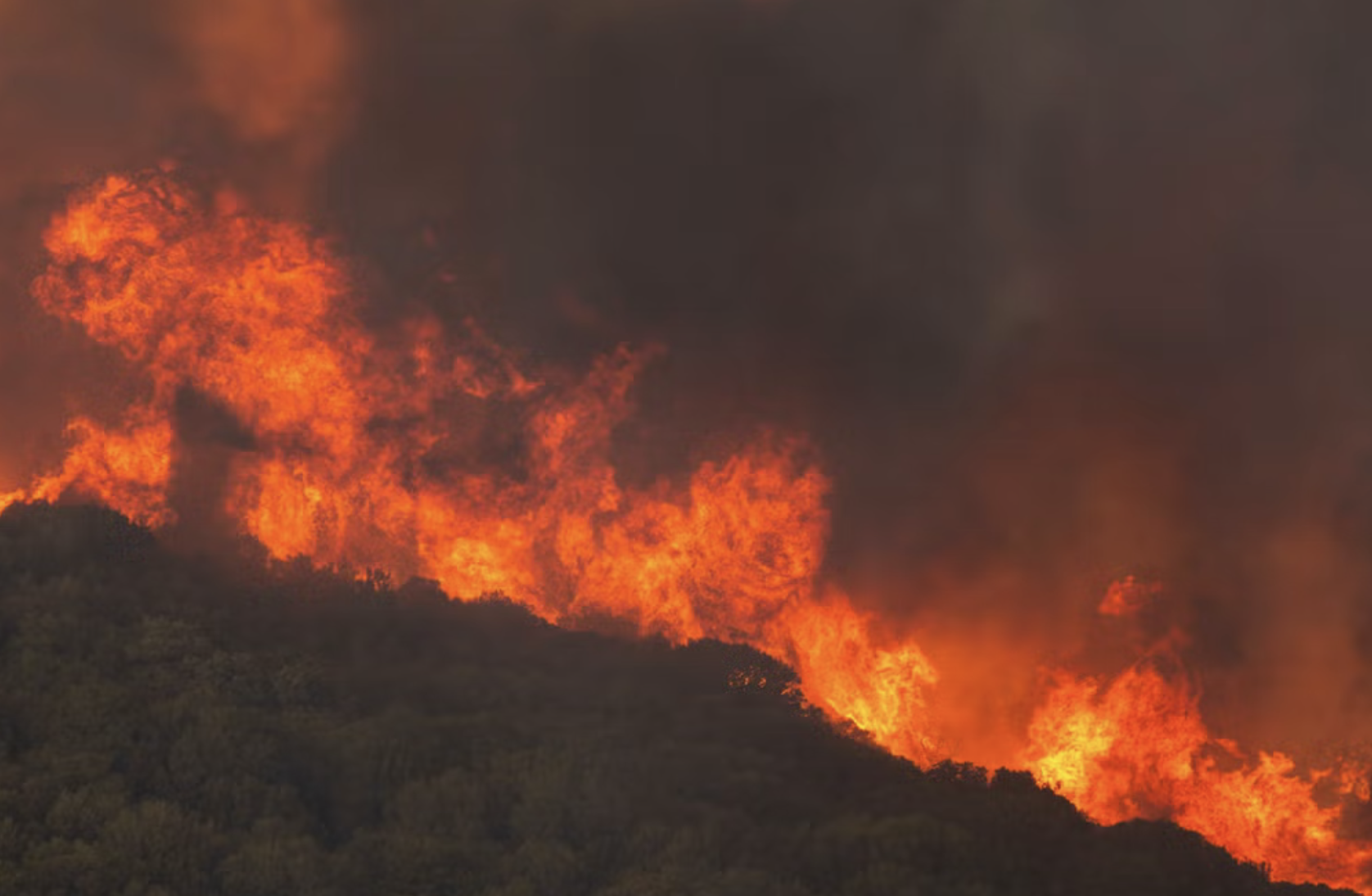
Wildfire burning in northern Greece. Image via Associated Press
Where did these fires coming from? Some say that unusually high temperatures and strong winds literally fanned the flames of some of the worst wildfires seen in decades. In addition to the devastating loss of lives and livelihood, vulnerable pieces of cultural heritage were severely damaged.
Now that the fires are no longer burning, cultural heritage experts around the world are able to identify scorched areas and initiate restoration efforts. Experts also pose this question: how to prevent such destruction by wildfire in the future? Especially when most of the world seems to take an ad hoc approach to cultural heritage restoration following natural disaster?
Greece
One of the hardest-hit areas was Greece. In August, Europe’s biggest wildfire in a century burned in northern Greece.
The fire covered an area larger than New York City, spanning 312 square miles. (For reference, New York City’s solid ground measures 302.6 square miles). Flames from this fire in northern Greece – primarily covering the regions of Evros, Rodopi, Alexandropoulis, Dadia, and northwestern Athens – proved devastating. The flames eradicated housing, farmland, and most of a national forest. In Evros, many took part in forced evacuations but, tragically, many lives were lost to the fires.
In early August, shocking damage occurred on the Grecian island of Rhodes. Satellite images showed Rhodes as a black scar of extensive damage. Evacuations in response to the flames forced thousands of residents to flee their homes and tourists to abandon their accommodations. The evacuations also prevented tourists from visiting cultural heritage hotspots that the island is known for. Namely, its legendary medieval village – a storied and mysterious acropolis built by crusaders within 4-km-long medieval stone walls.
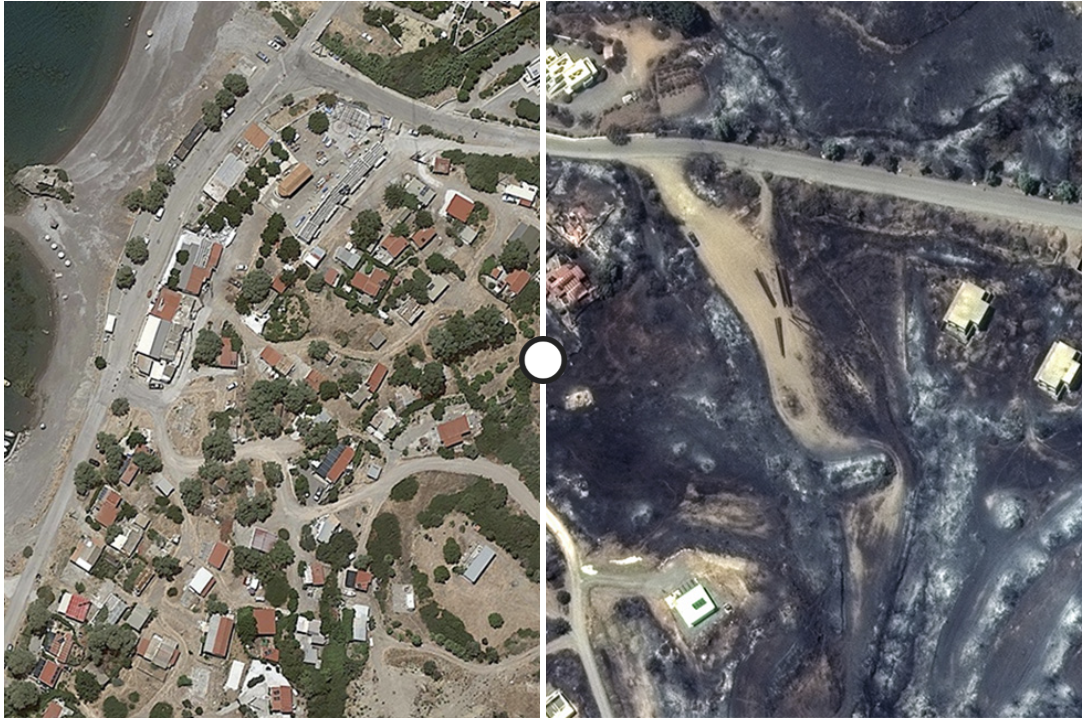
Side-by-side aerial photos of Rhodes, Greece takein in 2019 (left) and 2023 (right). Image via BBC News.
From the beginning, this medieval town has been imbued with legends and dreams of glory. According to the island’s history, Rhodes was transformed into a fortified city by the Knights of St. John of Jerusalem in 1309. The Knights’ occupation was so strong, in fact, that they held the island until 1523 – surviving several takeover attempts by Turkish and Egyptian conquerors.
Military prowess aside, the Knights outdid themselves in terms of city planning. Once on the island, rather than destroying the “ancient core” of the place (which was a perfect grid – the product of 408 B.C., Hippodamian-style city planning), the Knights incorporated their plans for a fortified center as an extension of the ancient design. They further divided the town into a northern quarter, called the “Chateau,” and a southern quarter, called the “Ville.” The Chateau was where the Knights would hang out in their personal residences. They also made sure to stop by the palace of the Grand Master of the Order, which was bigger and fancier than their own abodes. Additionally (and likely for their own convenience), the Knights also made sure that all of the administrative buildings, hospital, and cathedral were located in the northern end. The Ville, in contrast, housed the laity. It’s also where the synagogues and other churches were constructed, as well as the noisy (and predictably odorous) public street market.
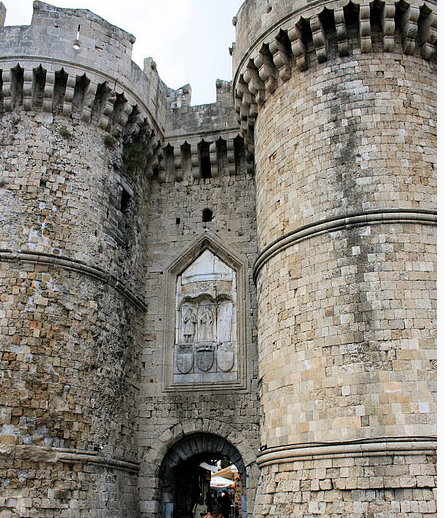
Medieval City of Rhodes. Image by Olbertz via Wikipedia.com.
When the Knights constructed these buildings, they went all-out in terms of style. Gothic and Renaissance designs, with a hint of Ottoman influences and a touch of Byzantine detail, manifested in a sensational conglomeration of art and architecture. Some of the buildings originally constructed as churches were later converted to mosques. Of the sacred spaces that remained churches, Agia Triada (the Holy Trinity), Agios Athanasios (St. Athanasius), Agia Alkaterini (St. Catherine), and Panagia tou Kastrou (the Virgin of the Castle), house gorgeous pieces of art and cultural heritage. The church of Agia Triada, for example, boasts stunning, original frescos. Sections of the fresco depict scenes from Ezekiel’s prophetic visions in the Bible. Other portions illustrate powerful images of Jesus’s Crucifixion on the Cross. And those frescos only scratch the surface in any tourist’s quest to discover the cultural heritage on this illustrious island.
Thankfully, the fires on Rhodes were eventually contained. Damage reports following the fires in Greece allowed cultural heritage to assess where restoration efforts would be needed. Inspections by the Climate Crisis and Civil Protection Ministry teams revealed the status of various architectural structures on-site. On Rhodes, six buildings were been designated by officials as unsafe for use. Twenty-two additional buildings were declared temporarily unfit, and seventeen others have been flagged as needing minor repairs.
The worst damage on Rhodes seems to have occurred in the local areas containing homes, hotels, businesses, and nature reserves. In fact, more than fifty homes, several popular resorts, and over 50,000 olive trees – a source of income for locals – were completely destroyed. Religious sanctuaries also suffered. The Monastery of Panagia Ipseni, in particular, became a verifiable inferno. The monastery’s olive orchards, vineyards, and religious icon workshop (all of which provided additional income for the monastery) were destroyed by the fire. The nuns – thankfully – were spared, yet had to endure watching their home erupt in flames, and their beautiful mosaic courtyard disappear under a layer of soot and ash.
However, the medieval city of Rhodes emerged relatively unscathed – possibly due to location and sheer luck. Even so, it is essential to acknowledge that, for Rhodes’ cultural heritage, escaping total destruction by wildfire was a very narrow victory. Moreover, even minor, “cosmetic” damage to ancient structures by wildfire smoke and extreme temperatures causes deterioration. The charred buildings, such as those seen in Lindos, indicate extensive damage to architecture. Extreme elements threaten to accelerate natural deterioration of delicate art within the medieval city. This alone poses increased dangers for those wishing to preserve Rhodes’ storied history. Restoration and preservation work must be given funding when rebuilding the city from the ashes in order to maintain Rhodes as a cultural heritage destination. Additionally, Grecian officials should consider enacting proactive measures geared toward cultural heritage, as well as putting in place orchestrated fire response protocols. Proactive preservation and planned response teams may save the day if this delicate art and architecture is threatened by natural disaster again.
Croatia
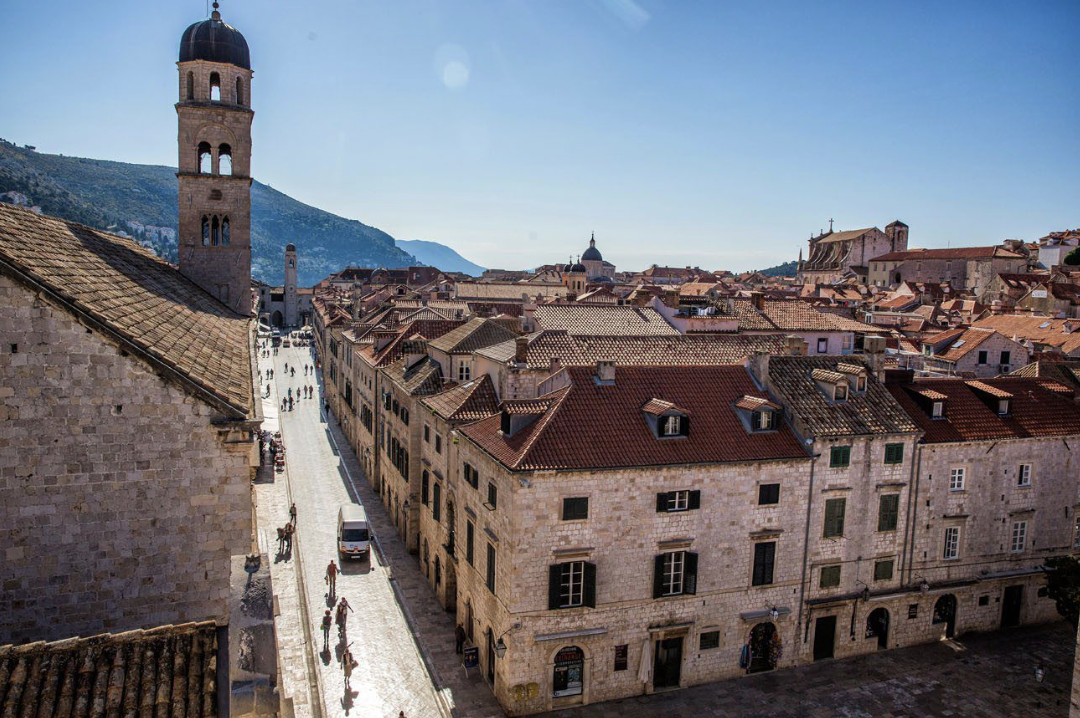
The Dubrovnik Walls in Croatia. Image via earthtrekkers.com.
Croatia’s stunning city of Dubrovnik marks a second European medieval town that narrowly escaped complete destruction of cultural heritage by wildfire this summer. Those lucky enough to have visited Croatia known that Dubrovnik houses vast artistic and architectural treasures. The Old City of Dubrovnik, referred to as the ‘Pearl of the Adriatic’, is listed as one of UNESCO’s World Heritage Sites. Dubrovnik emerged as a powerful city on the Dalmatian coast in the 13th century. The resulting influx of financial wealth produced a city that is a true jewel of art and artistry: Dubrovnik acts as guardian for an array of stunning churches, monasteries, palaces, and fountains. Each exquisite work of architecture demonstrates a celebration of Gothic, Renaissance, and Baroque artistic styles.
Last summer, fires in Croatia spread just south of the ancient city. Firefighters bravely fought to contain the fire, as an additional concern was that the wildfires would set off aircraft and landmines leftover from war in the 1990s. Deployment of the explosives would have posed even greater danger to the city and its beautiful cultural heritage. Fortunately, the southerly winds shifted and, with the aid of emergency personnel on the ground, Croatians were able to protect Dubrovnik’s residents and cultural heritage from damage.
Hawaii
The wildfires on Maui, Hawaii came as a shock to Americans – and were heartbreakingly deadly. 97 people were confirmed deceased, many of them children. In light of this, it is imperative to point out that the loss of cultural heritage is not the worst outcome of wildfire. Loss of human lives is the greatest tragedy; in events of wildfire and all other forms of natural disaster, loss of lives calls for our upmost recognition and respect.
The following discussion on the implications of damage done to Hawaii’s cultural heritage in the wake of the same fire should by no means overshadow the lives lost. Rather, it is intended to bring awareness to the delicacy of cultural heritage on the island, in the hopes that, by doing so, we may greater protect it in the future.
Lahaina, on the island of Maui, maintains an important place in the history of Hawaii. Listed on the National Register of Historic Places, the town rose to prominence as a whaling city in the mid-1800s. Interestingly, Lahaina was also the location of a printing press that produced the first-ever newspaper printed in the Hawaiian language. The four-page weekly paper, printed on Valentine’s Day, 1834, was called “Ka Lama Hawaii.”
Missionaries that arrived in the 1820s built Western-style architecture, including the Baldwin Home. The home was built by Rev. Ephraim Spaulding in 1834 – the same year as the Ka Lama Hawaii’s debut publication. Rev. Spaulding later returned to Massachusetts, and then lent the house to Rev. Dwight Baldwin (for whom the home is now named). Why Rev. Spaulding chose to live in the snowy echelons of Massachusetts, as opposed to the gorgeous views of Lahaina, is anyone’s guess. Regardless, the Baldwin House has since been converted into a museum, and is believed the be the oldest-surviving residence on Maui. A visit to the museum is a lesson in missionary life in an 1820s Hawaiian village – visitors can expect a tour of the house and grounds, as well as a peek into the vibrant, busy lift of the Baldwins’. The family knew how to throw a good party, and often received members of Hawaii’s royal court. For Lahainans in the 1840s, it was the place to see-and-be-seen.
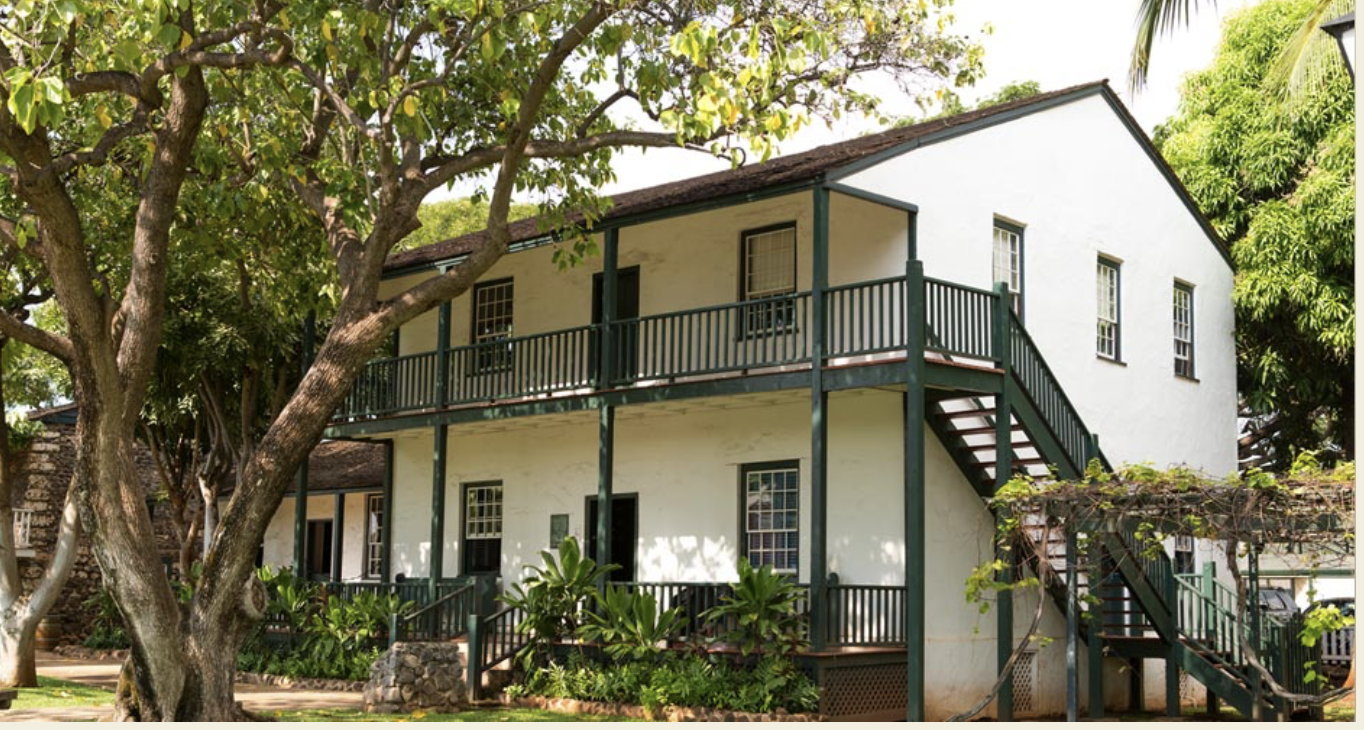
The Baldwin Home on Lahaina in Maui, Hawaii. Image via Lahaina Restoration Foundation.
Unfortunately, the Baldwin Home is one of many buildings that suffered extensive damage in the fire. The House had a wooden roof, which was completely burned by flames. The Baldwin Home Museum’s director, Theo Morrison, stated (shortly after the fire) that he suspected “the entire building was gutted.” This was later confirmed.
As more reports following the fire on Maui were released, damage to other precious cultural heritage sites on the island was to be expected. Reports – most tellingly, those from Native Hawaiians – revealed that cultural landmarks, art, and architecture crucial to the Hawaiian cultural narrative were destroyed. This includes sites on Lahaina were the first Hawaiian Constitution during the kingdom era was written in the 1800s, and an ancient fish pond where Hawaiian monarchs were known to take their rest and leisure.
Although Maui is often touted as a tourist site, for Native Hawaiians, it has been long-known as the heart of their storied history. In this light, the impact of cultural heritage lost by the wildfires points to the power and enduring influence of irreplaceable art, artifacts, and historic sites. The art community must look to ways to proactively prevent vulnerable pieces of cultural heritage from destruction by extreme natural weather events. The reality is that damage done to treasured works of art and cultural heritage anywhere causes the world to lose crucial components of shared human history.
Who’s to Blame?
As the world continues to reflect on the summer wildfires, many seek to find a scapegoat for the destruction. Climate change, arson, and inefficient government response teams have all been blamed. However, at this stage in the world’s evolution, pointing fingers does little to solve the problem at hand. Loss of delicate art and cultural heritage by natural disaster is part of the new normal. If art is to be preserved for future generations, proactive protection measures should be the first line of defense.
The second line of defense should be an increased awareness of the importance of preserving such heritage, and a place for that awareness in planning for orchestrated response efforts.
The third line of defense? It’s a call to individual action, and it comes from Smokey.
by Amineddoleh & Associates LLC | Sep 29, 2023 |
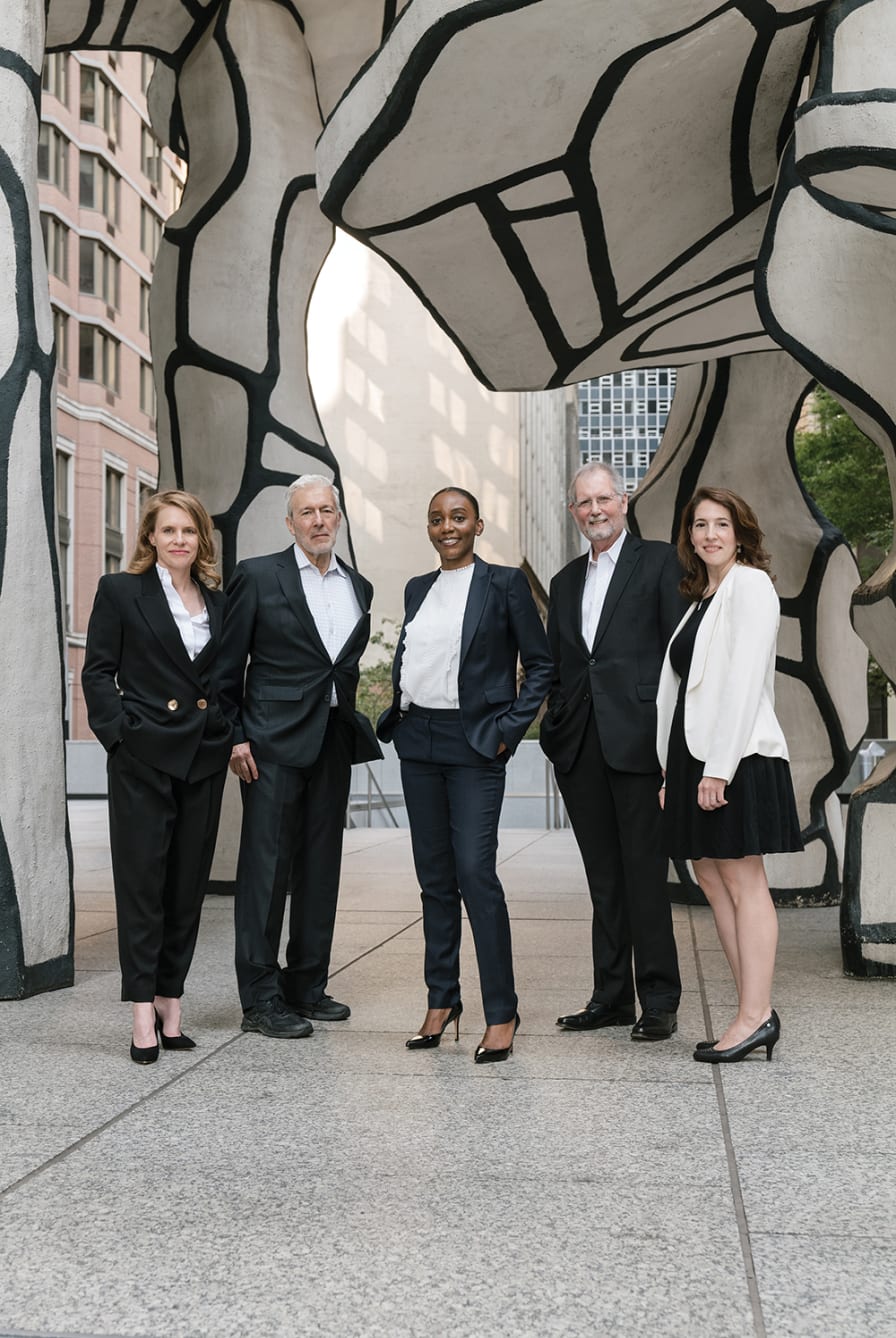 Our founder, Leila Amineddoleh, has recently been featured in New York Metro Super Lawyers Magazine, alongside other leaders in her field. Leila was chosen for the piece as a top-rated intellectual property, art, and cultural heritage lawyer well-known in the industry for getting the job done right. This means advocating both for her clients, and for the art and cultural heritage at issue.
Our founder, Leila Amineddoleh, has recently been featured in New York Metro Super Lawyers Magazine, alongside other leaders in her field. Leila was chosen for the piece as a top-rated intellectual property, art, and cultural heritage lawyer well-known in the industry for getting the job done right. This means advocating both for her clients, and for the art and cultural heritage at issue.
In the article, Leila’s experience working with our former client (and now current friend) Laura Young, is highlighted. Young is our client who found an Ancient Roman marble bust at her local Goodwill in Austin, TX. Our firm has written previously about Leila’s and Laura’s story. Read the incredible journey one Roman bust took from Germany to Texas (and how he found his way home) here.
In the piece by Super Lawyers, Leila’s success working with Laura is illustrative of her signature manner taking care of her clients by providing insight on best practices in the art law field. In Leila’s words, her work as a lawyer requires giving this special level of attention. She says it can require coming up with “creative solutions . . . . As a lawyer, you find out what’s important to someone.”
Later in the article, Leila gives her thoughts on changing attitudes on lawsuits involving stolen antiquities. She connects the rise of modern lawsuits brought by claimants for contested works to a 1995 international investigation in Italy. That investigation exposed many thought-to-be honest dealers as thieves, and revealed and auction houses to be engaging in deceptive practices. Leila explains how the impact of this investigation continues to call objects held by museums, collectors and auction houses into question, leading to an on-going return of hundreds of objects and works of art.
Leila’s success has launched her and her namesake firm to even greater heights. It is an honor to be featured alongside other esteemed colleagues this stand-alone piece. In it, Leila and her colleagues give important guidance on the current industry challenges for art lawyers. Read the piece here.

















 Our founder, Leila Amineddoleh, has recently been featured in New York Metro Super Lawyers Magazine, alongside other leaders in her field. Leila was chosen for the piece as a top-rated intellectual property, art, and cultural heritage lawyer well-known in the industry for getting the job done right. This means advocating both for her clients, and for the art and cultural heritage at issue.
Our founder, Leila Amineddoleh, has recently been featured in New York Metro Super Lawyers Magazine, alongside other leaders in her field. Leila was chosen for the piece as a top-rated intellectual property, art, and cultural heritage lawyer well-known in the industry for getting the job done right. This means advocating both for her clients, and for the art and cultural heritage at issue.